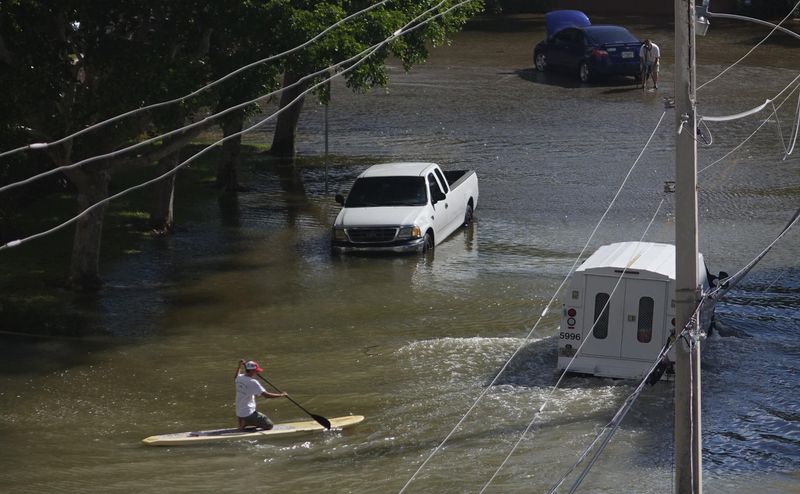
Rising sea levels are a fact of life, as king tides like this one show, and it's going to get worse. (JOE CAVARETTA / Sun Sentinel/South Florida Sun Sentinel)
By JIM CARROLL
Flood insurance
This year — Oct. 1 to be exact — the cost of federal flood insurance is going up dramatically because of sea-level rise and climate change.
For years, flood insurance from FEMA’s National Flood Insurance Program has been priced artificially low and heavily subsidized by the Treasury Department.
Now, after innumerable worsening flood disasters, FEMA is instituting “Risk Rating 2.0,” which for the first time looks at individual properties’ flood risks and prices policies accordingly.
Rates for a primary residence are going up by as much as 18% annually, and there will be surcharges and fees on top of that.
Risk Rating 2.0 will also greatly increase the number of Florida property owners required to buy the pricier flood insurance. Property ownership costs, property values, and Florida’s real estate market in general will soon be significantly affected.
Property insurance
Due to losses from hurricanes and coastal flooding from sea-level rise and climate change, this year Florida’s insurance carriers have applied for 26% to 34% rate increases on property insurance. That translates to a minimum $700 increase in the average Florida homeowner’s 2021 property insurance premium.
Carriers in Florida are also dropping tens of thousands of policyholders, and some carriers are going belly-up. According to Bloomberg and insurance industry analyses, the insurance industry may soon leave Florida altogether.
Mortgages
Sea levels in South Florida could rise 8 inches by 2030 and 17 inches by 2040 — that’slong before payoff of a 30-year mortgage taken out today.
So, banks have begun to lend less money, require higher down payments (up to 40%), charge higher mortgage rates, and require the purchase of mortgage insurance more often.
Property values
Because of rising seas, property values in coastal Florida are falling.
Florida lost about $5.4 billion in home value from 2005 to 2017, according to First Street Foundation, which analyzes the impact on communities of climate change and rising seas.
From 2018 to 2020, home prices in exposed areas in Florida dropped by another 5% to 10%, according to an October 2020 Wharton School study.
Exposed homes in Florida are likely to lose an additional 5% to 15% in value between now and 2030, i.e., an additional $10 billion to $30 billion drop in value, consulting firm McKinsey concluded recently.
Flooding
Climate change and sea-level rise are making hurricanes stronger and storm-surge flooding worse. Recent history suggests we’ll be threatened this year and in most years to come by Category 5 hurricanes and massive storm-surge flooding.
Palm Beach County got lucky in September 2019 when Hurricane Dorian took a sharp northward turn between the Bahamas and Florida’s coast, saving the county from 185 mphwinds and a 20-foot storm surge that would have pounded the area for hours.
Tidal flooding also is getting worse. The “sunny day” king tides that flood South Florida coastal cities every year are getting steadily worse. Tidal flooding is damaging Miami-Dade right now, particularly Miami Beach. According to the First Street Foundation, the frequency of tidal flooding from rising seas will likely grow in coastal Florida from a few days a year to 30 to 60 days a year by 2030.
Beaches
Beaches are why we’re here and why people visit and buy real estate. But in Palm Beach County now, 33 of the county’s 47 miles of beach are critically eroded. In too many places, expansive beach playgrounds have turned into skinny, eroded sand cliffs that have left homes and high-rises a chip shot away from rising seas. Ditto in Broward, Dade and much of the rest of Florida’s coastline.
The $50 million allocated annually by the Legislature to replenish disappearing beaches falls far short of what’s required to address the problem.
Now or never
To tackle sea-level rise and associated right-now problem areas, we have to overhaul and update coastal Florida’s flood control systems, raise roads, build sea walls, protect drinking-water supplies and adequately replenish beaches and dunes.
The costs to do all that will be, frankly, stupefying. Not long ago, Delray Beach got a $378 million estimate to protect 3 miles of shoreline. The price to build sea walls protecting coastal Florida would be about $75 billion.
The only way these projects can be done is if unprecedented, monumental state and federal assistance is provided right away. Or tomorrow we’ll be staring into the abyss.
Jim Carroll is a Riviera Beach attorney and environmental activist, and was a candidate for the Florida House of Representatives in 2020.
“The Invading Sea” is the opinion arm of the Florida Climate Reporting Network, a collaborative of news organizations across the state focusing on the threats posed by the warming climate.